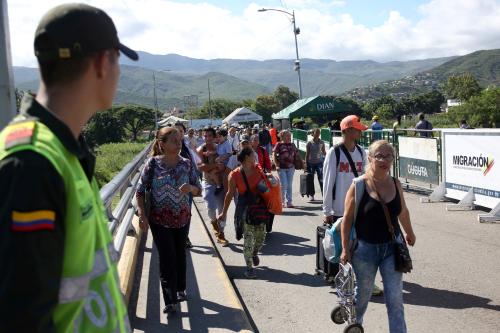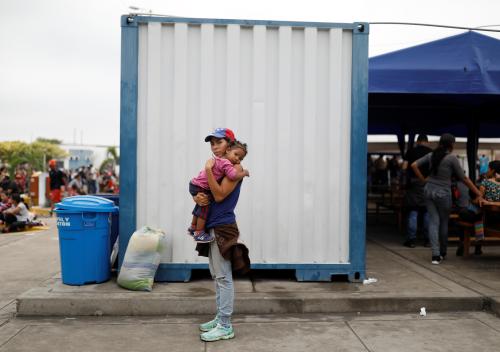After years of displacement, Venezuelan refugees are finally a topic of national discussion in the United States. Since 2014, nearly 7 million Venezuelans have fled their country due to a humanitarian catastrophe and massive violation of human rights, becoming the second-largest displacement crisis in the world today, after Ukraine. Their situation is so desperate that, in order to reach the United States, they need to cross seven countries, passing through the very dangerous Darién Gap, the jungle linking South to Central America between Colombia and Panama. Many simply don’t make it.
It is sad that despite all that, it was Republican Governors Greg Abbot, Doug Ducey, and Ron DeSantis who raised this topic to national attention by using immigrants arriving in their states—most of them Venezuelans—as their own political tools by sending them on buses, often misleading them, to cities in the northeast of the country. These moves, some claim, are akin to human trafficking. As of now, we are talking about over 10,000 immigrants who have fallen into this disgraceful practice.
But the truth is that the governors should be designing smart policy with regard to these immigrants and refugees who represent nothing less than a huge asset to the labor force of this country, if given the opportunity.
Welcoming these immigrants is not a burden, but a blessing, especially now when labor markets are tight and labor shortages are adding fuel to an inflation that is already boiling.
Data based on surveys of hundreds of these immigrants shared with me by Humanitarian Action, an NGO that has been receiving and providing humanitarian assistance to thousands of these migrants as they arrive by bus in Washington, D.C. and New York City, shows this huge potential very clearly.
This population of immigrants—predominantly men of Venezuelan origin—is especially young, with an average age of 30 and ranging between 18 and 55. This is clear from the figure below comparing these immigrants to the American workforce as per data of the Bureau of Labor Statistics. In particular, nearly 80 percent of these Venezuelan migrants are between ages 20 to 34, compared to 20.4 percent of Americans.

Moreover, according to this data, the immigrants represent a workforce that can contribute to the U.S. economy as much-needed fundamental workers or even in more advanced occupations: Over 50 percent of them have completed high school and nearly 20 percent have completed an advanced technical degree or even a college degree.
In fact, when asked about the occupation they last held before migrating, many answered they’ve worked in the food and construction industries. Others declared to have worked in more complex occupations, as nurses, technicians, or even engineers—coincidentally, all occupations that are in very high demand right now and will continue to be in the future, according to the most recent BLS national projections.
If the governors were really interested in doing policy, they would have looked at the labor demand data of their own states. Short-term occupational projections for the state of Texas, for example, show that by 2023 the state will need nearly 26,000 additional fast-food and counter workers, 27,000 home health and personal care aides, 15,000 customer service representatives, and 9,000 nurses, among others. Similar trends are predicted in Arizona and Florida, with additional need for waiters, cooks, janitors and cleaners, as well as software developers, accountants, and general operations managers.
The receiving states, such as New York and Massachusetts, have similar trends in labor demand, and as such the governors of these receiving states should in fact be thanking their Republican colleagues for the young and resilient new additions to the local labor force.
The reason we see growing demand for these very different groups of occupations—some of them fundamental and some of them more advanced—is because, simply put, for each doctor in Arizona doing her job, she must count on several fundamental workers that complement her work, from drivers and cooks to assistants and nurses. And without these occupations, the doctor simply cannot do her job.
Thus, if sanity would reign in this country, politicians would have realized by now that welcoming these immigrants is not a burden, but a blessing, especially now when labor markets are tight and labor shortages are adding fuel to an inflation that is already boiling.
In this sense, there is one thing President Biden can do immediately to allow these immigrants to join the labor force: extend eligibility of the existing temporary protected status for Venezuelans to include those that arrived after March 2021, which would immediately give work permits to these thousands of workers. The job of these governors who are bussing and flying immigrants across the country is not to spend taxpayer money creating a national controversy for their own political gain, but rather to use this opportunity to come together and support this move, too. Doing so would assure that the governors are not only acting humanely with people in need, but also helping them to reach their full potential in a new place they want to call home.
This controversy should serve as a reminder that America’s debate on immigration needs more policy and less politics.
The Brookings Institution is committed to quality, independence, and impact.
We are supported by a diverse array of funders. In line with our values and policies, each Brookings publication represents the sole views of its author(s).







Commentary
Politicians are playing politics with refugees, but these workers are exactly what the US economy needs
September 29, 2022